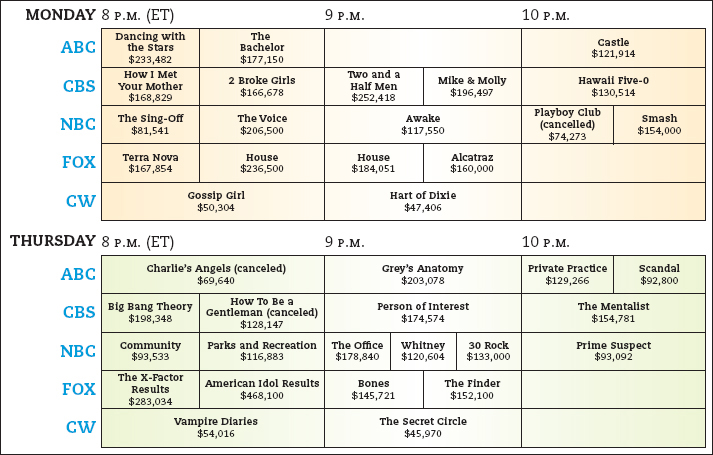Money In
Printed Page 250
Sources of revenue differ in some respects between TV and cable. Both broadcast network and cable programming make money from syndication and from advertising, but only cable also makes money from subscriptions—monthly fees charged to consumers for different tiers of service.

Syndication
Syndication—leasing TV stations the exclusive right to air older TV series—is a critical source of revenue for broadcast networks and cable companies. Early each year, executives from thousands of local TV stations gather at the world’s largest "TV supermarket" convention, the National Association of Television Program Executives (NATPE), to acquire programs that broadcast networks (and, more recently, cable channels) have put up for syndication. Networks might make cash deals—selling shows to the highest-bidding local station—or give a program to a local station in exchange for a split in the advertising revenue, usually called a barter deal, as no money changes hands. Through this process, the stations obtain the exclusive local market rights, usually for two- or three-year periods, to network-created game shows, talk shows, and evergreens—popular reruns such as the Andy Griffith Show, I Love Lucy, or Seinfeld. Buying syndicated programs is usually cheaper for local TV stations than producing their own programs, and it provides a familiar lead-in show to the local news.
Many local stations show syndicated programs during fringe time—immediately before the evening’s prime-time schedule and following the local evening news or the network’s late-night talk show. Syndicated shows filling these slots are either "off-network" or "first-run." In off-network syndication, older programs, such as Everybody Loves Raymond, that no longer run during network prime time are made available as reruns to local stations, cable operators, online services, and foreign markets. First-run syndication is any non-network program specifically produced for sale only into syndication markets, such as the Oprah Winfrey Show or Wheel of Fortune.
Advertising
Advertising is another major source of revenue for the industry. TV shows live or die based on how satisfied advertisers are with the quantity and quality of the viewing audience. Since 1950, the major organization tracking and rating prime-time viewing has been Nielsen, which estimates what viewers are watching in the nation’s major markets. Ratings services provide advertisers, networks, and local stations with considerable detail about viewers—from race and gender to age, occupation, and educational background.
In TV measurement, a rating is a statistical estimate, based on a random sample, expressed as the percent of households tuned to a program in the total market being sampled. Another audience measure is the share, which gauges the percent of homes tuned to a program compared with those actually using their sets at the time of the sample. Prime-time advertisers want to reach relatively affluent 18- to 49-year-old viewers, who account for most consumer spending. If a show is attracting those viewers, advertisers will compete to buy time during that program (see Figure 8.2). Traditionally, shows that did not reach enough of the "right" viewers wouldn’t attract advertising dollars—and thus risked being canceled. But in the age of niche markets and Internet competition, smaller audience ratings and shares are tolerated, especially in cable programming.

The average costs in 2011 for a thirty-second commercial during popular prime-time programs on network television for a Monday and Thursday night.
Source: Brian Steinberg, "‘American Idol,’ NFL Duke It Out for Priciest TV Spot," AdAge Mediaworks, October 24, 2011, http://adage.com/article/mediaworks/chart-americanidol-nfl-duke-priciest-tv-spot/230547/
Advertising also brings in money for cable. Most basic cable channels block out time for local and regional ads from, for example, restaurants, clothing stores, or car dealerships in the area. These ads are cheaply produced compared with national network ads, and they reach a smaller audience.
Subscriptions
In addition to making money from syndication and from selling local ads, cable companies also earn revenue through monthly subscriptions for basic service, pay-per-view programming, and premium movie channels. Cable companies charge the customer a monthly fee—on average between $40 and $50 per month in 2009—and then pay cable channels like CNN or ESPN 35¢ to more than $3 per customer per month for these basic cable services. Whereas a cable company might pay HBO or Showtime $4 to $6 per month per subscriber to carry one of these premium channels, the company can charge each customer $10 or more per month—reaping a nice profit.